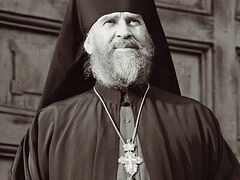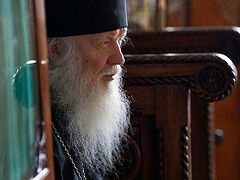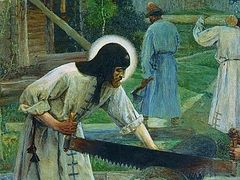—Throughout its history, even during the troubled Soviet era, the Holy Trinity–St. Sergius Lavra remained the center of Orthodoxy, the destination of prominent statesmen and Church figures—grand princes, tsars, metropolitans, patriarchs. Today churches are open, monasteries are being actively revived, but the Lavra still remains a special place, “the heart of Orthodoxy.” Did this happen thanks to St. Sergius or because of the advantageous position of the monastery near Moscow?
—I think Moscow became great because the Holy Trinity–St. Sergius Lavra, the spiritual heart of Russia, was nearby. Who knows how the course of history of Muscovy (the Grand Principality of Moscow) could have been changed without it... Maybe our capital would have been in Tver? There were also other independent centers in Russia during the lifetime of St. Sergius: Veliky Novgorod, Pskov, the Principality (or, rather, republic) of Vyatka, which is completely forgotten today—the last stronghold of “people’s freedom.” But, nevertheless, they all gathered around this spiritual center. And thanks to the Lavra, Muscovy, in fact, achieved dominance and Russia became what it is today. Though now few bother to even think about it.
Why were people drawn to Moscow and gathered around it? They were attracted not only by its churches and monasteries, but also by the personality of St. Sergius, who in every possible way affirmed the dominance of the grand princes of Moscow. Because a State must have a center, otherwise it inevitably becomes de-centralized. And then everything begins to fall apart and several “borderlands” appear, each pulling in its own direction. Muscovy could have suffered the same fate: it would have simply collapsed without these spiritual bonds.
 Restored cross at Dormition Cathedral, early 1946. Photo: stsl.ru
Restored cross at Dormition Cathedral, early 1946. Photo: stsl.ru
— I recall my grandmother’s stories about the re-opening of the monastery in 1946 when the Lavra was returned to the Russian Orthodox Church by order of Stalin. Twenty-five years after the closure of the monastery, people with real spiritual hunger donated literally everything they had to it. She said that the empty basins, from which the church floors had been washed before the first Paschal service in many years, were filled to the brim with money. And then monks, many of whom had been tonsured before the Russian Revolution, began to arrive. Do you think there is a spiritual continuity between the first monks who revived the Holy Trinity–St. Sergius Lavra and its modern inhabitants?
—Of course! It’s another matter that when we look at ourselves, we see ourselves as spiritual pygmies, the unworthy heirs of those spiritual giants. And this is obvious in many ways. Our beloved long-term choir-director of the Holy Trinity–St. Sergius Lavra, Archimandrite Matthew (Mormyl; 1938—2009), said that when he was a young boy in 1947, he came from his native Ukraine to the Lavra. And there he saw how the whole church congregation was singing the Paschal Canon by heart. Just imagine: all the people who were standing in the church were singing the Paschal Canon by heart.
That is, now not only have the monks changed—ordinary believers have changed as well. People were absolutely different then. Compared to them, we with all our ebooks, tablets and advanced technology (which, unarguably, give us the opportunity to familiarize ourselves with the wealth of our Orthodox heritage) are perhaps deprived of something important, some kind of core strength, some special spiritual integrity, the very real spiritual thirst that guided those people. For them, every spiritual book was an event engraved deep in their hearts. And now we have an abundance of virtual and digital libraries. We are free to read as much as we like! But how many of us live this way now? If you dare to make someone read something by St. Ignatius (Brianchaninov), he will start to moan and groan in a couple of pages! Even not all monastics can read his writings, let alone seminarians. They complain, “His language is too complicated and outdated... And It’s hard to read the Holy Fathers—you can go crazy!”
—Exactly. One day as I came out of the Lavra bookstore with a three-volume edition of St. Philaret (Drozdov)’s works, three young men in cassocks said to me, “Are you really going to read those books?!”
—Yes, that’s the point! In fact, the standards that we had before have dropped dramatically. When everything is easily available, what we have doesn’t seem valuable to us. But those generations, though deprived of this spiritual wealth, knew how to appreciate it. They discovered this wealth in every grain of knowledge, in every event that happened in their lives, in every spiritual conversation, in contact with the holy elders... And today, even if we had ten spiritual fathers like Archimandrites Kirill (Pavlov) or Naum (Bayborodin), visited by thousands of people, there is no guarantee that our spiritual life would flourish! Because people would come and ask them totally empty, banal and worldly questions, ones which would not enrich them spiritually, and would not give the elders the opportunity to share grace with others. Therefore, everything depends on our readiness, on our desire to follow this path and to perceive the spiritual wealth that we have.
Look at Western Europe, for example: how many great saints there were! Take St. Honoratus of Lérins in Gaul [a co-founder of Lérins Monastery and Archbishop of Arles. D. c.429; feast: January 16.—Trans.]. He was the St. Sergius of southern Gaul of the fifth century! The eulogy for him reads, “Which nations have not sent disciples to him to struggle at the monastery of Saint-Honorat Island that he founded!” So what? Now three miles away from Saint-Honorat Island, the famous Cannes Film Festival is annually held and the attention of the whole world is riveted on what happens on the red carpet of Cannes, and not on the Lérins Islands where St. Honoratus, entirely and undeservedly forgotten in the West, struggled in the ascetic life. And God forbid that this should happen in Russia with St. Sergius!
We celebrate the uncovering of the saint’s relics, trying to make the feast as solemn as possible lest we forget the spiritual treasure that we possess and lose it.
—We can’t help but recall how these holy days were spent before: old men and women would settle on the benches and on the grass beside the Dormition Cathedral. Many of them stayed overnight here. Churches were open, and singing was coming from them. All this resembled scenes of old Russia of a bygone age. But over the past year and a half the Lord has made some “adjustments,” and today the Lavra is not only a magnet for tourists, as it was until recently. Surely now the brethren’s life has become easier, hasn’t it?
-Yes, of course! As one of our priests said in a sermon, “The Lord has given us a ‘Sabbath year,, during which we are ‘taking a break’ from the Chinese!” Thus, in a sense, this is a relief for us. On the other hand, St. Sergius may have found sparks of spiritual treasure in some individual representatives of that nation who visited our monastery in great multitudes. Who knows!
— Yes. The ex-deputy abbot of the Holy Trinity–St. Sergius Lavra, Archimandrite Pavel [Krivonogov; since 2019—abbot of the Monastery of St. Savva of Storozhev.—Trans.], testified that some of Chinese tourists had converted to Orthodoxy.
—I know a wonderful priest who converted to the Orthodox faith after visiting the Monastery of St. Sergius. His name is Father Theodore Tobler. He is a pure-blooded German and lives in the small town of Bischofsheim an der Rhön in Bavaria. He was a monk, a choir-director and for seven years struggled in a German Benedictine monastery. And at some point he embarked on a spiritual journey. His spiritual sister, Mother Nadezhda (now reposed), recalled how they arrived at the Monastery of St. Sergius, and the future Fr. Theodore stood for an hour and a half at the relics of the saint, then walked away and, completely transformed, said with a radiant face, “Now I understand that we must become Orthodox!” So they, still young people, united by friendship from childhood, a Catholic monk and mother Nadezhda (half-American and half-German) both converted to Orthodoxy, began to work as teachers at a school in that German town and, with their salaries, first bought a brewery, then a former disco, and set up a monastery there. With their own funds they had two churches built there: in honor of St. Nektarios of Aegina and blessed Procopius of Ustyug. In the very heart of Germany! These are miracles that occur in our days! And it is still a spiritual center to which a huge number of Russian Germans (who have returned to their forgotten homeland) are drawn. And not only Germans, but also many emigrants: Serbs, Greeks and other Orthodox Christians who live and work in Germany. They go there, in a sense, to another home of St. Sergius, to the fruits of his prayers and amazing transforming power.
Here is another example. In Milan there is a very interesting priest: Archimandrite Dimitry (Fantini). He is also an outstanding surgeon, still practicing. Once having received a strict Catholic education, he became disillusioned with Catholicism and embraced Protestantism. Later, again as a tourist, he found himself here at the Lavra of St. Sergius, at the saint’s relics. A visit to the monastery was enough for this man to take up monasticism, be ordained a priest and later become an archimandrite of the Russian Orthodox Church. And now he is the rector of one of the Orthodox parishes in the city of Milan. An amazing pastor who embraces everybody with his love, gathering around himself Russian, Moldovan, Ukrainian, Georgian and other so-called “forced emigrants” who have ended up in Italy and are looking for connection with their faith. And Fr. Dimitry is like a mother to them, embracing everyone with his love and the grace that he once sensed and acquired from the relics of St. Sergius.
There are many such instances. Who has not come here! And many left our monastery as Orthodox: Hindus, Egyptians, Mexicans, Chinese and people from different countries of Europe, Africa and America. Recalling the text of the eulogy for St. Honoratus of Lerins, we can likewise say of St. Sergius, “Which nation has not sent him its children as disciples!”
—That is, the “birds” that were once shown to St. Sergius in a wondrous vision, today have even flown to Western Europe. In addition to your words, I recall the story of Archbishop Michael (Donskov), the retired Archbishop of Geneva and Western Europe. In the 1950s, he visited the Holy Trinity-St. Sergius Lavra and was amazed at the sight of the monastery, its monks and their welcoming attitude towards him, then a young man. Perhaps that event later served as a turning point in his biography. I also remember the film director and actor Norbert Kuchinke (1940—2013), who literally trod on the heels of Archimandrite Matthew (Mormyl), asking him “to sing so that his hair would stand on end.” This was the personal attitude of the inhabitants of the Lavra of the previous generations to everyone who came to them, which is so close to the spirit of Christ and St. Sergius. And people could understand that they have not been abandoned, something that we all really lack today.
—Yes, indeed! I also remember how Elder Naum, who lived nearby and received pilgrims, once said to his spiritual child who was entrusted the heavy cross of the archpastoral ministry in a very remote part of our country, “Well, go and build stoves for bear cubs there!” Slightly allegorical words: what kind of stoves and bear cubs? It is us, the people who have “gone wild” and desperately need spiritual warmth! And we always received it here at the Lavra, from Fathers Kirill, Naum, other father-confessors and, of course, from St. Sergius himself.
Indeed, a person, like a bear cub, freezing in a spiritually cold, frozen world, looks for a “burning stove” by which he can “get warm” and receive spiritual warmth. And the Lavra is like a big burning stove, where there is St. Sergius of Radonezh, where there are also smaller “stoves”—our spiritual fathers and elders. And everyone with the help of God will find this spiritual warmth if he chooses to “sit down” here in front of the fire, “warming up his frozen arms and legs.” Welcome! We invite everyone to the Monastery of St. Sergius with his spiritual grace, which through his prayers does not dry out, always exists and always pours out on those who want to come and receive its warmth.
— And I have already received my share of this warmth and this grace, Fr. Nektary! “And like the sun thou didst shine on thy fatherland…”—we sing in the akathist hymn to St. Sergius. I really want all of us to turn to him as if he were alive and remember his life, podvig and his closeness to each one of us as often as possible.
—Venerable Father Sergius, pray to God for us!






